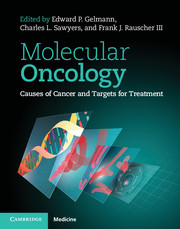Book contents
- Frontmatter
- Dedication
- Contents
- List of Contributors
- Preface
- Part 1.1 Analytical techniques: analysis of DNA
- Part 1.2 Analytical techniques: analysis of RNA
- Part 2.1 Molecular pathways underlying carcinogenesis: signal transduction
- Part 2.2 Molecular pathways underlying carcinogenesis: apoptosis
- Part 2.3 Molecular pathways underlying carcinogenesis: nuclear receptors
- Part 2.4 Molecular pathways underlying carcinogenesis: DNA repair
- Part 2.5 Molecular pathways underlying carcinogenesis: cell cycle
- Part 2.6 Molecular pathways underlying carcinogenesis: other pathways
- 40 The ubiquitin/proteasome pathway in neoplasia
- 41 Small silencing non-coding RNAs: cancer connections and significance
- Part 3.1 Molecular pathology: carcinomas
- Part 3.2 Molecular pathology: cancers of the nervous system
- Part 3.3 Molecular pathology: cancers of the skin
- Part 3.4 Molecular pathology: endocrine cancers
- Part 3.5 Molecular pathology: adult sarcomas
- Part 3.6 Molecular pathology: lymphoma and leukemia
- Part 3.7 Molecular pathology: pediatric solid tumors
- Part 4 Pharmacologic targeting of oncogenic pathways
- Index
- References
41 - Small silencing non-coding RNAs: cancer connections and significance
from Part 2.6 - Molecular pathways underlying carcinogenesis: other pathways
Published online by Cambridge University Press: 05 February 2015
- Frontmatter
- Dedication
- Contents
- List of Contributors
- Preface
- Part 1.1 Analytical techniques: analysis of DNA
- Part 1.2 Analytical techniques: analysis of RNA
- Part 2.1 Molecular pathways underlying carcinogenesis: signal transduction
- Part 2.2 Molecular pathways underlying carcinogenesis: apoptosis
- Part 2.3 Molecular pathways underlying carcinogenesis: nuclear receptors
- Part 2.4 Molecular pathways underlying carcinogenesis: DNA repair
- Part 2.5 Molecular pathways underlying carcinogenesis: cell cycle
- Part 2.6 Molecular pathways underlying carcinogenesis: other pathways
- 40 The ubiquitin/proteasome pathway in neoplasia
- 41 Small silencing non-coding RNAs: cancer connections and significance
- Part 3.1 Molecular pathology: carcinomas
- Part 3.2 Molecular pathology: cancers of the nervous system
- Part 3.3 Molecular pathology: cancers of the skin
- Part 3.4 Molecular pathology: endocrine cancers
- Part 3.5 Molecular pathology: adult sarcomas
- Part 3.6 Molecular pathology: lymphoma and leukemia
- Part 3.7 Molecular pathology: pediatric solid tumors
- Part 4 Pharmacologic targeting of oncogenic pathways
- Index
- References
Summary
Focus of the chapter
Despite a few intuitive theories in the sixties that proposed a regulatory role for RNA in controlling gene expression through base-pair complementarity (1,2), the subsequent discovery of transcription factors quenched any further research in this field. As a consequence, for many years RNA has been regarded exclusively as the intermediary molecule between DNA and protein, with the primary role of carrying the genetic information necessary for protein synthesis. Intriguingly, only about 2% of human DNA accounts for protein-coding genes and the total number of proteins does not vary significantly among different species. On the other hand, the extent of non-protein-coding DNA, regarded for a long time as junk DNA, increases proportionally with developmental complexity (3) and over 90% (4) of the genome is actually transcribed in a developmentally regulated manner to produce non-coding RNA (ncRNA) that can be inter-genic, intronic, or overlapping with protein-coding transcripts (5–7). In addition, ncRNAs display precise tissue-expression patterns (8) and are differentially expressed in pathologic conditions such as cancer, and immune or heart diseases (9; for review see 10).
ncRNAs can be conventionally divided into long and small RNAs. Long ncRNAs include those greater than 200 nucleotides (nt) in length that can reach up to 100kb (11,12). Their function and characterization is still underway; however, it is already clear that this heterogeneous class displays important regulatory functions, as shown in developmental processes where they can regulate expression of homeotic genes, oncogenes, and metabolic genes (10). Despite their smaller size, small RNAs are equally important in development, cell biology, and disease, and their discovery triggered the general interest of the scientific community for ncRNAs. Currently, a total of 7053 small RNAs are annotated by Gencode, 85% of which correspond to four major classes: small nuclear (sn)RNAs, small nucleolar (sno)RNAs, miRNAs, and transfer (t)RNAs (13; for small RNA classification and main characteristics, see Table 41.1). In this chapter we will focus mainly on small silencing RNAs that include: microRNAs, which are the most studied class of ncRNAs; piwi-interacting RNAs (piRNAs), which are germline-specific ncRNAs, and finally a brief reference to the most recently identified class of small silencing RNAs, which consists of endogenous small interfering RNAs (endo-siRNAs).
- Type
- Chapter
- Information
- Molecular OncologyCauses of Cancer and Targets for Treatment, pp. 481 - 496Publisher: Cambridge University PressPrint publication year: 2013

